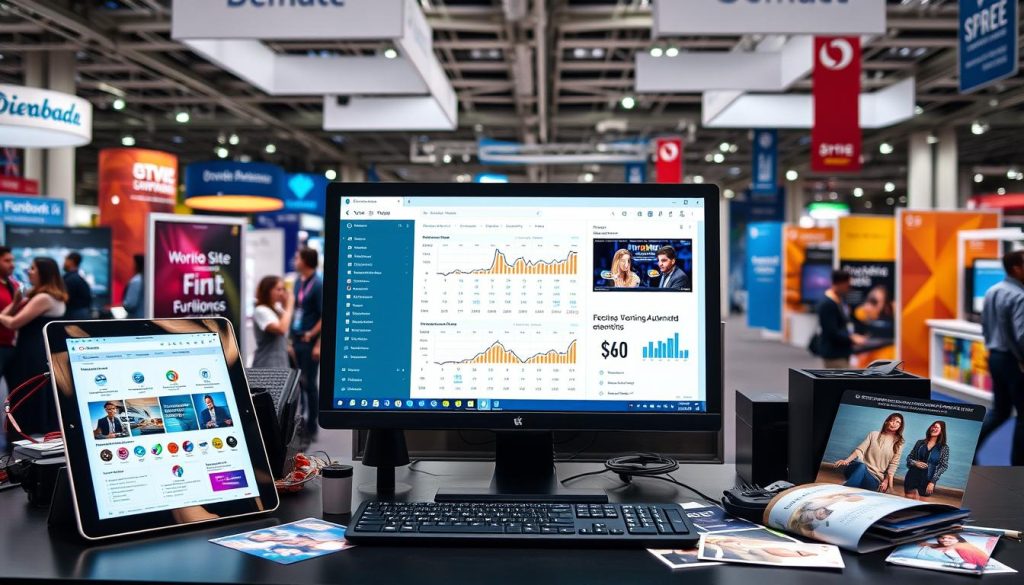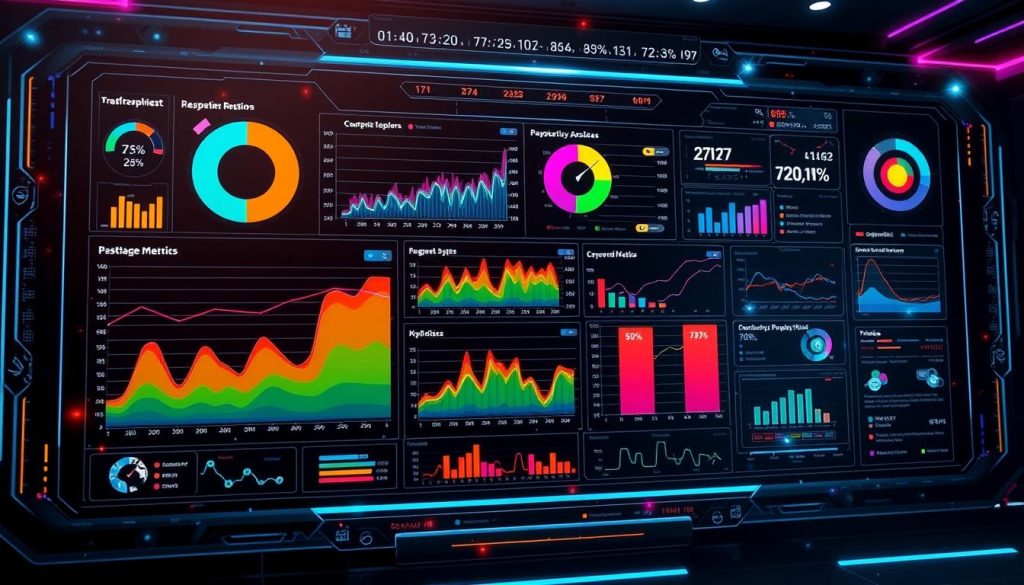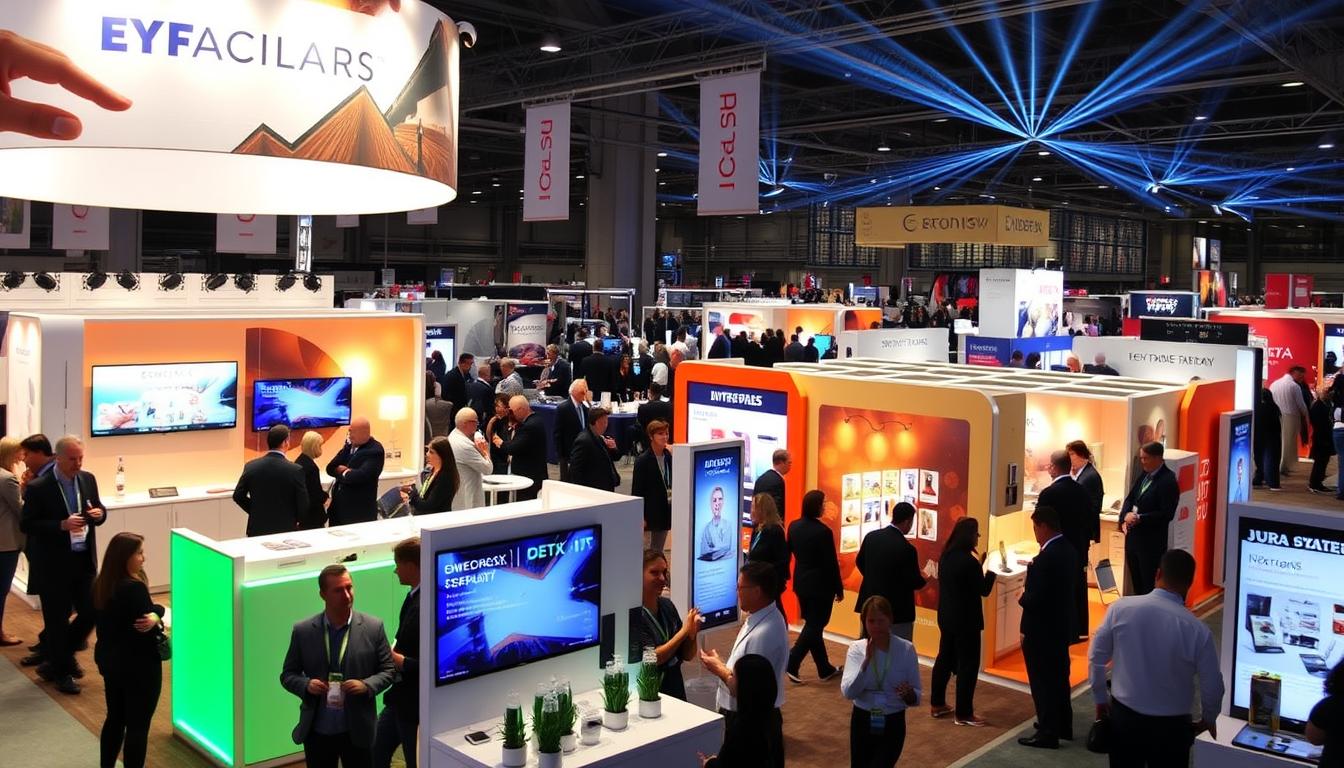Tradeshows remain a powerful tool for businesses to showcase products, network, and generate leads. But in today’s fast-paced digital world, knowing how to optimize your tradeshow strategy is crucial. This guide will walk you through effective tradeshow planning and event marketing automation techniques to help you stand out in the crowded exhibition hall.
From pre-show preparations to post-event follow-ups, we’ll explore innovative ways to engage attendees, leverage technology, and maximize your return on investment. Whether you’re a seasoned exhibitor or new to the tradeshow scene, these insights will help you create a memorable presence and drive meaningful results.
Key Takeaways
- Set clear, measurable goals for your tradeshow participation
- Integrate digital elements to enhance physical booth experiences
- Utilize event marketing automation for efficient lead management
- Design an interactive booth that tells your brand story
- Implement data-driven strategies to track and improve performance
- Leverage technology to boost attendee engagement
- Conduct thorough post-event analysis to refine future strategies
Understanding the Modern Tradeshow Landscape
The tradeshow world is changing fast. Exhibitors need new strategies to keep up with shifting trends and tech advances. Let’s explore how the industry is evolving and what it means for your next event.
Current Industry Trends and Challenges
Today’s tradeshows blend the physical and digital. Exhibitors face the challenge of standing out in a crowded space while delivering value to tech-savvy attendees. Effective contact management is key to maximizing connections made at these events.
Digital Integration in Physical Events
Smart exhibitor strategies now include digital tools to boost attendee engagement. Virtual reality demos, mobile apps, and interactive displays are becoming standard. These tech solutions help create memorable experiences and gather valuable data.
Evolution of Attendee Expectations
Attendees now expect personalized, immersive experiences. They want to interact, learn, and connect in new ways. Experiential marketing has become crucial. Successful exhibitors focus on creating unique, shareable moments that resonate long after the event ends.
“The future of tradeshows lies in blending cutting-edge technology with human connection.”
By understanding these shifts, you can craft exhibitor strategies that truly engage your audience and stand out in the modern tradeshow landscape.
Strategic Pre-Show Planning and Goal Setting
Effective tradeshow planning starts with a solid strategy. Setting clear objectives and allocating resources wisely can significantly boost your return on investment (ROI). Let’s dive into the key elements of pre-show planning that can set you up for success.
Defining Measurable Objectives
Start by outlining specific, measurable goals for your tradeshow participation. These might include:
- Number of qualified leads generated
- Sales volume or new contracts signed
- Brand awareness metrics
- New partnerships formed
By setting concrete targets, you’ll have a clear benchmark for evaluating your tradeshow performance.
Budget Allocation and ROI Projections
Careful budgeting is crucial for maximizing your tradeshow ROI. Consider these key expense categories:
| Expense Category | Typical Percentage | Considerations |
|---|---|---|
| Booth Space | 30-35% | Prime location vs. cost savings |
| Booth Design | 15-20% | Reusable elements for future shows |
| Marketing Materials | 10-15% | Digital vs. print collateral |
| Travel & Accommodations | 20-25% | Early booking discounts |
| Staffing | 10-15% | Training and incentives |
Project your expected ROI based on past performance and industry benchmarks. This will help justify your tradeshow investment and guide your strategy.
Timeline Development and Milestone Creation
Create a detailed timeline with key milestones to keep your tradeshow planning on track. Utilizing a comprehensive dashboard can help streamline this process and ensure nothing falls through the cracks.
By following these strategic pre-show planning steps, you’ll be well-positioned to make the most of your tradeshow investment and achieve your business objectives.
From Engagement to Automation: How to Optimize Your Tradeshow Strategy
Tradeshows have evolved beyond simple product displays. To truly stand out, exhibitors must embrace innovative techniques to optimize their tradeshow strategy. The key lies in blending traditional engagement with cutting-edge automation.
Event marketing automation is revolutionizing how businesses approach tradeshows. By streamlining processes, companies can focus on what matters most: connecting with potential clients. Automation tools help manage leads, schedule follow-ups, and analyze performance in real-time.
To optimize your tradeshow strategy, consider these actionable steps:
- Implement chatbots for instant visitor engagement
- Use RFID technology for seamless lead capture
- Leverage social media scheduling tools for consistent online presence
- Employ AI-driven analytics for real-time performance insights
“Automation is not about replacing human interaction, but enhancing it to create more meaningful connections at tradeshows.”
The impact of automation on tradeshow success is significant. Let’s examine the benefits:
| Aspect | Without Automation | With Automation |
|---|---|---|
| Lead Capture | Manual, prone to errors | Quick, accurate, digital |
| Follow-ups | Delayed, inconsistent | Immediate, personalized |
| Performance Tracking | Post-event analysis | Real-time insights |
| Resource Allocation | Fixed throughout event | Dynamic, data-driven adjustments |
By integrating these automated solutions, you’ll not only enhance engagement but also gain valuable insights to continually refine your tradeshow approach. Remember, the goal is to create a seamless experience that resonates with attendees long after the event ends.
Designing an Impactful Booth Experience
Crafting a memorable booth experience is crucial for successful exhibitor strategies. By blending innovative design, interactive elements, and cutting-edge technology, you can create a space that captivates attendees and leaves a lasting impression.
Interactive Display Elements
Engage visitors with hands-on experiences that showcase your products or services. Consider incorporating touchscreens, virtual reality stations, or interactive product demos to encourage participation and boost brand recall.
Technology Integration Solutions
Leverage technology to enhance your booth’s appeal and functionality. Implement lead capture systems that seamlessly collect visitor data, or use augmented reality to bring your offerings to life. These tech-driven solutions can significantly improve your experiential marketing efforts.
Brand Storytelling Through Design
Your booth design should tell your brand’s story. Use visual elements, color schemes, and innovative layouts to create an immersive environment that resonates with your target audience. Consider the following design elements:
- Eye-catching graphics and signage
- Comfortable seating areas for in-depth conversations
- Product display zones that highlight key features
- Digital screens for dynamic content presentation
| Design Element | Purpose | Impact on Visitor Experience |
|---|---|---|
| Interactive Touchscreens | Product Exploration | Increases engagement and information retention |
| VR/AR Stations | Immersive Demonstrations | Creates memorable, shareable experiences |
| Branded Lounge Area | Networking Space | Facilitates meaningful conversations and connections |
By focusing on these key aspects, you can create a booth that not only attracts attention but also drives meaningful interactions and supports your overall tradeshow objectives.
Lead Generation and Data Collection Methods
Tradeshows offer unique opportunities for lead generation tactics and data analytics. By combining traditional methods with cutting-edge technology, businesses can maximize their return on investment.
One effective approach is to use interactive touchscreens for capturing attendee information. These devices allow visitors to input their details quickly, reducing friction in the data collection process. Paired with a GoHighLevel expert service, businesses can streamline their lead management and follow-up strategies.
QR codes have also gained popularity for their ease of use. Attendees can scan codes to access product information, enter contests, or join mailing lists. This method not only collects valuable data but also provides instant engagement.
For a more personal touch, consider using RFID-enabled badges. These allow for passive data collection as attendees move through the event space, providing insights into booth traffic and engagement levels.
| Method | Data Collected | Engagement Level |
|---|---|---|
| Interactive Touchscreens | Contact Info, Preferences | High |
| QR Codes | Digital Footprint, Interests | Medium |
| RFID Badges | Movement Patterns, Dwell Time | Low |
Remember, the key to successful lead generation is not just collecting data, but analyzing and acting on it promptly. Use real-time analytics tools to adjust your strategy on the fly and make the most of your tradeshow presence.
Leveraging Event Marketing Automation Tools
Event marketing automation is revolutionizing how businesses handle tradeshows. By integrating smart tools, companies can streamline their processes and boost engagement. Let’s explore how these tools can transform your tradeshow strategy.

CRM Integration Strategies
Connecting your Customer Relationship Management (CRM) system with event platforms creates a seamless flow of information. This integration allows for real-time updates and personalized interactions with attendees. By syncing attendee data, you can tailor your approach and boost engagement rates throughout the event.
Automated Follow-up Systems
Post-event follow-up is crucial for converting leads into customers. Automated systems can send personalized emails, schedule follow-up calls, and track responses. This ensures no lead falls through the cracks and maintains momentum after the event ends.
Data Synchronization Solutions
Efficient data management is key to successful event marketing automation. Synchronizing data across platforms ensures all teams have access to the most up-to-date information. This alignment allows for better decision-making and more targeted marketing efforts.
- Real-time lead scoring
- Automated attendee segmentation
- Instant reporting and analytics
By leveraging these event marketing automation tools, businesses can maximize their tradeshow ROI and create lasting connections with attendees. The key is to choose solutions that integrate smoothly with existing systems and align with your specific event goals.
Maximizing Attendee Engagement Through Technology
Tradeshows are evolving, and technology is at the forefront of this transformation. Innovative solutions are reshaping attendee engagement and experiential marketing strategies. Let’s explore some cutting-edge technologies that can elevate your tradeshow presence.
Virtual reality (VR) experiences transport attendees to immersive brand worlds. Imagine showcasing your products in a 360-degree virtual environment, allowing visitors to interact with your offerings in ways impossible in traditional setups. This technology creates lasting impressions and boosts brand recall.
Gamification elements inject fun into the tradeshow experience. Interactive quizzes, scavenger hunts, or leaderboard challenges encourage participation and foster a sense of friendly competition. These engaging activities not only entertain but also educate attendees about your products or services.
Augmented reality (AR) apps bring static displays to life. By pointing their smartphones at booth elements, visitors can access additional information, 3D product models, or even entertaining animations. This blend of physical and digital creates a truly memorable experience.
- Interactive touchscreen displays
- RFID-enabled personalized experiences
- Live social media walls
- AI-powered chatbots for instant engagement
By leveraging these technologies, you can create a dynamic and engaging booth that stands out from the crowd. Remember, the goal is to provide value and create meaningful connections with your audience. Embrace innovation, but always keep your attendees’ needs at the center of your experiential marketing strategy.
Measuring Success: Analytics and KPIs
Tradeshow success hinges on effective measurement. Smart use of data analytics helps businesses gauge their performance and calculate return on investment (ROI). Let’s explore key methods for tracking and analyzing tradeshow outcomes.
Real-time Performance Tracking
Modern tech allows for instant insights during events. Booth traffic counters, digital lead capture systems, and social media monitoring tools provide live data. This real-time info lets teams adjust strategies on the fly for better results.

Post-Event Analysis Methods
After the show, deep dive into collected data. Compare lead quality and quantity against pre-set goals. Analyze attendee feedback and engagement metrics. These insights shape future strategies and prove event value to stakeholders.
ROI Calculation Frameworks
Measuring return on investment is crucial for justifying tradeshow participation. Use this formula:
| ROI Calculation | Formula |
|---|---|
| Basic ROI | (Revenue Generated – Total Costs) / Total Costs x 100 |
| Lead Value ROI | (Number of Leads x Average Lead Value – Total Costs) / Total Costs x 100 |
| Long-term ROI | (Lifetime Customer Value x New Customers – Total Costs) / Total Costs x 100 |
By applying these analytics and ROI frameworks, businesses can turn tradeshow data into actionable insights, driving continuous improvement in their event strategies.
Conclusion
Mastering how to optimize your tradeshow strategy is crucial in today’s dynamic business landscape. By embracing modern exhibitor strategies, companies can create memorable experiences that resonate with attendees long after the event concludes.
The key to success lies in striking a balance between engagement and automation. Interactive displays and technology integration captivate visitors, while automated systems streamline lead management and follow-ups. This dual approach ensures maximum impact and efficiency.
Remember, your tradeshow success hinges on:
- Thorough pre-show planning
- Compelling booth design
- Effective lead generation techniques
- Smart use of event marketing tools
- Data-driven performance tracking
By implementing these strategies, you’ll not only stand out on the tradeshow floor but also drive measurable business results. Effective contact segmentation can further enhance your post-show marketing efforts, ensuring targeted follow-ups that boost conversion rates.
As the tradeshow landscape evolves, so should your approach. Stay innovative, adapt to new trends, and continually refine your strategies. With the right mix of creativity and data-driven decision-making, your tradeshow presence will yield impressive returns and foster lasting business relationships.
| Strategy Component | Impact on Success |
|---|---|
| Pre-show Planning | Sets clear objectives and expectations |
| Booth Design | Creates memorable brand experiences |
| Lead Generation | Builds valuable prospect database |
| Marketing Automation | Enhances follow-up efficiency |
| Performance Tracking | Enables continuous strategy refinement |
Additional Resources and Tools
Ready to take your tradeshow planning to the next level? We’ve got you covered with a handpicked selection of resources and tools to boost your event marketing game. From cutting-edge software to insightful guides, these assets will help you streamline your efforts and maximize results.
For those looking to master event marketing automation, check out platforms like Cvent and Bizzabo. These powerhouses offer all-in-one solutions for registration, attendee engagement, and post-event analytics. Want to up your lead capture game? Tools like Leadfeeder and Omnily.io can help you turn booth visitors into qualified leads effortlessly.
Don’t forget to brush up on industry trends and best practices. The Trade Show News Network (TSNN) offers a wealth of articles and webinars on tradeshow planning strategies. For a deep dive into event tech, the Event Tech Brief newsletter is a must-read. With these resources at your fingertips, you’ll be well-equipped to create unforgettable tradeshow experiences that drive real business results.
FAQ
How can I optimize my tradeshow strategy for better results?
To optimize your tradeshow strategy, focus on pre-show planning, setting clear objectives, designing an engaging booth, leveraging event marketing automation, and implementing effective lead generation tactics. Also, prioritize attendee engagement through interactive experiences and use data analytics to measure your performance and calculate ROI.
What are some current trends in the tradeshow industry?
Current trends include digital integration in physical events, increased focus on experiential marketing, the use of virtual and augmented reality for immersive experiences, sustainability initiatives, and the adoption of event marketing automation tools for streamlined processes and improved attendee engagement.
How can I maximize attendee engagement at my booth?
To maximize attendee engagement, consider incorporating interactive display elements, technology integration solutions, and brand storytelling through design. Utilize gamification, virtual reality experiences, and personalized interactions to create memorable experiences that resonate with your target audience.
What are some effective lead generation tactics for tradeshows?
Effective lead generation tactics include using lead capture apps, implementing QR code scans for quick information exchange, hosting interactive contests or quizzes, offering personalized product demonstrations, and leveraging social media check-ins. Don’t forget to follow up promptly with automated email sequences after the event.
How can I measure the success of my tradeshow participation?
Measure your tradeshow success by tracking key performance indicators (KPIs) such as the number of leads generated, booth traffic, social media engagement, and post-event conversions. Use real-time performance tracking during the event and conduct thorough post-event analysis. Calculate your return on investment (ROI) by comparing the costs incurred to the value of leads and opportunities generated.
What role does event marketing automation play in tradeshow strategy?
Event marketing automation plays a crucial role in streamlining processes, enhancing attendee experiences, and improving post-event follow-up. It can help with CRM integration, automated follow-up systems, and data synchronization. This technology allows you to personalize communications, track attendee behavior, and efficiently manage leads throughout the event lifecycle.
How can I design an impactful booth experience?
Design an impactful booth experience by focusing on brand storytelling, incorporating interactive display elements, and integrating cutting-edge technology. Ensure your booth layout facilitates easy flow and engagement. Use eye-catching graphics, demonstrations, and experiential marketing techniques to create a memorable and immersive environment for attendees.
What are some best practices for post-event follow-up?
Best practices for post-event follow-up include segmenting your leads based on interest and engagement level, sending personalized follow-up emails within 24-48 hours after the event, leveraging marketing automation for nurture campaigns, connecting on social media, and scheduling follow-up calls or meetings with high-priority leads. Ensure your follow-up strategy aligns with your overall sales and marketing goals.


